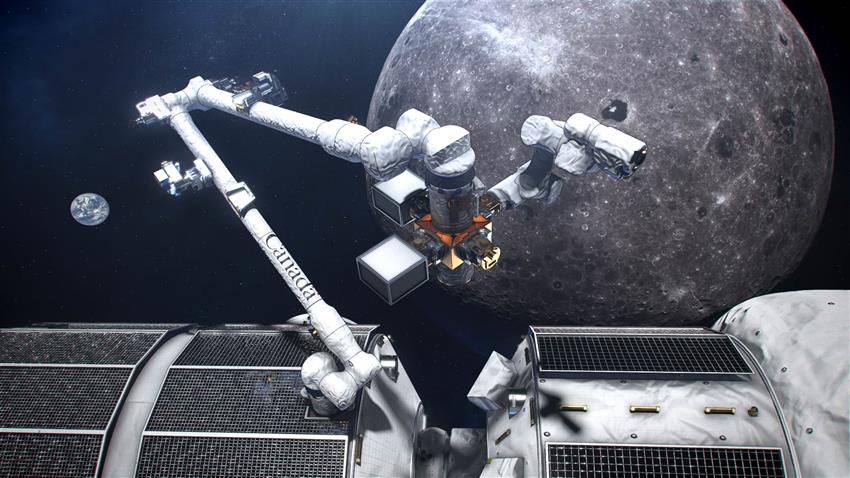About Canadarm3
Canadarm3 will be Canada's contribution to the US-led Gateway, a lunar outpost that will enable sustainable human exploration of the Moon. This robotic system will use cutting-edge software to perform some tasks around the Moon autonomously and without human intervention.
- Delivery date: No earlier than
- Status: In development
Components
The robotic system will include several distinct parts:
- a large, 8.5-metre-long arm
- a smaller, more dexterous arm
- a tool and on-orbit replaceable unit caddy
Animation of Canadarm3 operating on the exterior of Gateway, in orbit around Earth's Moon. (Credits: Canadian Space Agency, Bradley Reynolds, NASA/Alberto Bertolin)
Tasks
The next-generation Canadian robotic system could be used to:
- maintain, repair and inspect Gateway
- relocate Gateway modules
- help astronauts during spacewalks
- enable science in lunar orbit
- catch spacecraft visiting Gateway
Canadarm3 is designed to work autonomously. However, the system will also be operated by robotics flight controllers in Canada, or by Gateway if required.
Building on a legacy of leadership in space robotics
Canada is internationally recognized as a leader in space robotics. Our success in critical projects like Canadarm on the Space Shuttle fleet and Canadarm2 and Dextre on the International Space Station (ISS) have established Canada's reputation for excellence.
In return for contributing Canadarm3, Canada receives a range of opportunities for lunar science and technology demonstration, as well as two astronaut flights to the Moon. CSA astronaut Jeremy Hansen will be part of Artemis II, the first crewed mission to the Moon since .
How it will work
Canadarm3's smaller arm will be equipped to transfer mission-critical material between the interior and the exterior of Gateway.
The small arm will be able to help repair the larger arm in space if necessary and reduce the need for astronaut spacewalks. This means that, thanks to advances in autonomy, Canadarm3 will be able to maintain itself in space and swap out parts.

Official logo of Canadarm3. (Credit: CSA)
How Canadarm3 will move on Gateway
Each end of Canadarm3's arms will be able to attach to Gateway using specially designed interfaces on Gateway's exterior. Each anchoring "hand" will plug into an interface that supplies power, data, and video connections.
These interfaces will also allow the large and small arms to accomplish tasks, and will help store tools when not in use.
Impacts on Earth
Canadian robots on the ISS have led to the development of many technologies that benefit our lives here on Earth:
- neuroArm, the world's first robot capable of performing brain surgery inside an MRI machine
- IGAR, precision technology that has the potential to accelerate breast cancer diagnosis and treatment
- Modus V, a robotic digital microscope set to transform the way surgery is performed in hospitals
These spinoffs exemplify how space robotics and expertise developed in Canada help bring tangible benefits to people on Earth.
Who is working on Canadarm3?
MDA, based in Brampton, Ontario, is working on Canadarm3. Canadarm and Canadarm2 were built by MDA.
In , the CSA awarded MDA a contract to establish the technical requirements to build Canadarm3. Hundreds of Canadian companies are involved in its development, working with MDA and research organizations to drive innovation and Canadian excellence in emerging technologies.
When will it operate on Gateway?
The target date for delivering Canadarm3 to Gateway is no earlier than . This date may be adjusted in relation to the broader Gateway timeline.


